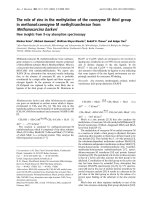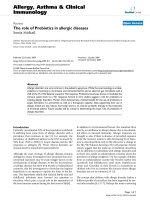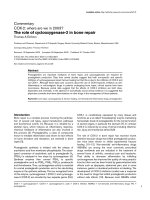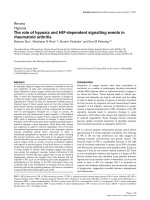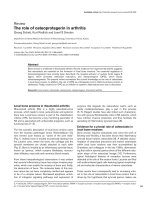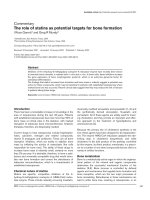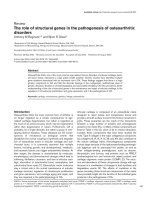Báo cáo y học: " The role of secretory leukocyte proteinase inhibitor and elafin (elastase-specific inhibitor/skin-derived antileukoprotease) as alarm antiproteinases in inflammatory lung disease" ppt
Bạn đang xem bản rút gọn của tài liệu. Xem và tải ngay bản đầy đủ của tài liệu tại đây (303.64 KB, 6 trang )
commentary
review
reports primary research
Review
The role of secretory leukocyte proteinase inhibitor and elafin
(elastase-specific inhibitor/skin-derived antileukoprotease) as
alarm antiproteinases in inflammatory lung disease
Jean-Michel Sallenave
Edinburgh Medical School, Edinburgh, Scotland, UK
Abstract
Secretory leukocyte proteinase inhibitor and elafin are two low-molecular-mass elastase
inhibitors that are mainly synthesized locally at mucosal sites. It is thought that their
physicochemical properties allow them to efficiently inhibit target enzymes, such as
neutrophil elastase, released into the interstitium. Historically, in the lung, these inhibitors
were first purified from secretions of patients with chronic obstructive pulmonary disease
and cystic fibrosis. This suggested that they might be important in controlling excessive
neutrophil elastase release in these pathologies. They are upregulated by ‘alarm signals’
such as bacterial lipopolysaccharides, and cytokines such as interleukin-1 and tumor
necrosis factor and have been shown to be active against Gram-positive and Gram-negative
bacteria, so that they have joined the growing list of antimicrobial ‘defensin-like’ peptides
produced by the lung. Their site of synthesis and presumed functions make them very
attractive candidates as potential therapeutic agents under conditions in which the
excessive release of elastase by neutrophils might be detrimental. Because of its natural
tropism for the lung, the use of adenovirus-mediated gene transfer is extremely promising in
such applications.
Keywords: adenovirus, elafin/elastase-specific inhibitor/skin-derived antileukoprotease, elastase, inflammation,
secretory leukocyte proteinase inhibitor
Received: 18 July 2000
Revisions requested: 3 August 2000
Revisions received: 7 August 2000
Accepted: 7 August 2000
Published: 23 August 2000
Respir Res 2000, 1:87–92
The electronic version of this article can be found online at
/>© Current Science Ltd (Print ISSN 1465-9921; Online ISSN 1465-993X)
A1-Pi = α1-proteinase inhibitor; ALP = antileukoprotease; ARDS = acute respiratory distress syndrome; bp = base pair; COPD = chronic obstruc-
tive pulmonary disease; ESI = elastase-specific inhibitor; IL = interleukin; kb = kilobases; LPS = lipopolysaccharide; SKALP = skin-derived
antileukoprotease; SLPI = secretory leukocyte proteinase inhibitor; TNF = tumor necrosis factor.
/>Introduction
Cytokines form one of the major classes of chemical
mediator responsible for initiating, regulating and termi-
nating the inflammatory response. Their synthesis, switch-
on and switch-off mechanisms and their mode of action
are tightly regulated in what is now classically called a
cytokine network. Indeed, early cytokines, such as inter-
leukin-1 (IL-1) and tumor necrosis factor (TNF), are syn-
thesized very quickly, within 1 h of the onset of inflamma-
tion, or in response to stimuli such as bacterial
lipopolysaccharides (LPS).
These cytokines set in motion the migration of inflammatory
cells such as neutrophils and monocytes, whose function
Respiratory Research Vol 1 No 2 Sallenave
is to eliminate the injurious agent and restore homeostasis.
To migrate from the vascular space and gain access to the
inflammatory site through the interstitium, it has been
hypothesized that these inflammatory cells use a variety of
proteases (such as neutrophil and monocyte/macrophage
metalloproteases and elastases).
To contain the potential injurious effects of excess release of
these proteases, the host secretes large amounts of antipro-
teinases, which also seem to have developed in a parallel
network, consisting of ‘alarm’ and ‘systemic’ inhibitors, the
latter being synthesized principally in the liver [such as α1-
proteinase inhibitor (A1-Pi) and antichymotrypsin].
We are particularly interested in the former group, which
include the two low-molecular-mass proteinase inhibitors
of the ALP family, antileukoprotease (ALP), also known as
secretory leukocyte proteinase inhibitor [1], mucus pro-
teinase inhibitor or bronchial inhibitor (it will henceforth be
referred to as SLPI), and elastase-specific inhibitor (ESI),
also known as elafin or skin-derived antileukoprotease
(SKALP) [2
•
]. They are synthesized and secreted locally at
the site of injury and are produced in response to primary
cytokines such as IL-1 and TNF; they might therefore be
part of a first wave of local, inducible defense in the
antiproteinases network [3]. Although potentially secreted
at many mucosal sites and sites of interface such as the
skin [2
•
], this review addresses mainly the role of SLPI and
elafin in the lung.
SLPI
Gene structure, protein and antiproteinase activity
SLPI is one of the two members of the ALP superfamily of
proteinase inhibitors (the other being ESI/elafin; see
below). The gene encoding SLPI [2.65 kilobases (kb) in
length [1]] seems to be a relatively nonpolymorphic, stable
gene that can be modulated at both the transcriptional
and translational levels [1]. Transfection studies with
fusion elements composed of fragments of up to 1.2 kb of
the 5′ flanking region of the SLPI gene demonstrated a
high promoter activity in a 131 base pair (bp) fragment
(–115 to +16) relative to the transcription start site. Inter-
estingly, Kikuchi et al [4] have recently delineated within
this region a proximal 41-bp region that confers lung
specificity for SLPI expression. It is a 11.7 kDa protein
consisting of 107 amino acid residues [1] and comprising
two domains. It contains 16 cysteine residues that form
eight disulfide bridges [1]. SLPI has been shown to inhibit
human neutrophil elastase, cathepsin G, trypsin, chy-
motrypsin and chymase. Its major target is thought to be
the human neutrophil elastase in view of its high affinity
and kinetic constants (inhibition constant in the nanomolar
range and k
ass
in the micromolar range) [5].
SLPI has been purified from different sources, including
parotid, cervical, seminal and lung secretions [1].
Cell and tissue distribution
In lung, SLPI is produced in vitro by tracheal, bronchial,
bronchiolar and type II alveolar cells, and by monocytes,
alveolar macrophages and neutrophils [1,6]. It has also
been shown to be produced in vivo by tracheal serous
glands and bronchiolar Clara cells, and to be closely asso-
ciated with elastin fibers in the alveolar interstitium [1]. Its
roles in inflammatory cells such as macrophages or neu-
trophils are uncertain but antibacterial or anti-inflammatory
actions have been proposed (see below). Outside the
lung, it is secreted in a variety of mucosal sites (leading to
its alternative name, mucosal proteinase inhibitor [1]).
ESI/elafin/SKALP
Gene structure, protein and antiproteinase activity
The neutrophil elastase inhibitor ESI/elafin (the other
member of the ALP superfamily of proteinase inhibitors;
reviewed in [2
•
]) was first identified as a ‘non-SLPI’ low-
molecular-mass anti-elastase by Hochstrasser et al [7]
and Kramps and Klasen [8], and further characterized by
us in bronchial secretions [9] and by Wiedow et al and
Molhuizen et al in the skin [10,11]. The sequence of the
gene for ESI [12] showed that it is approx. 2.3 kb long,
and is composed of three exons and two introns and con-
taining typical 5′ TATA and CAAT boxes, as well as 5′ reg-
ulatory sequences such as activator protein-1 and nuclear
factor-κB sites [2
•
]. Zhang et al demonstrated that a posi-
tive regulatory cis-element present in the region between
–505 and –368 bp is responsible for the upregulation of
the elafin gene in normal breast epithelial cells (reviewed
in [2
•
]). Further characterization will be needed to deter-
mine whether this region is tissue-specific or is also impor-
tant for expression in lung cells. The molecule is
composed of 117 amino acid residues, including a
hydrophobic signal peptide of 22 residues. Elafin is part of
a ‘four-disulfide’ core protein family that has recently been
termed the trappin family [2
•
]. Elafin can be divided into
two domains, the carboxy-terminal domain containing the
antiproteinase active site and the amino-terminal domain
containing characteristic VKGQ sequences (in single-
letter codes for amino acids). These sequences allow the
elafin molecule to glue itself into polymers and bind other
interstitial molecules through transglutamination [2
•
]. This
feature could make elafin maximally effective as a tissue-
bound inhibitor as opposed to A1-Pi, which is present in
large amounts in the circulation. SLPI has also been sug-
gested to have a locally protective role against neu-
trophilic damage, presumably because of its small size
and negative charge. The elafin molecule shows a 40%
homology with the SLPI molecule and the active sites of
both inhibitors are very similar.
Like SLPI, elafin has a high content of cysteine residues
[2
•
], which are arranged in four disulfide bonds in the C-ter-
minal proteinase-inhibiting region [2
•
]; a partial crystal
structure, not containing the VKGQ sequences (a major
commentary
review
reports primary research
/>feature of the molecule) has recently been determined [2
•
].
Elafin has been shown to be more specific in its spectrum
of inhibition than SLPI: it inhibits pig pancreatic elastase,
human neutrophil elastase and proteinase-3 [2
•
].
Cell and tissue distribution
As mentioned above, elafin was first demonstrated in the
skin and in lung secretions but is also present at mucosal
sites in many tissues. Its purification from sputum, its pres-
ence in tracheal biopsies and bronchoalveolar lavage from
both normal subjects and patients [13], and its synthesis
by Clara cells and type II cells indicate, as for SLPI, a
tracheo-bronchioalveolar origin. It is present in highest
concentrations in sputum (at approximately 10% of the
concentration of SLPI). We have recently investigated its
presence in the peripheral lung and have shown by
immunohistochemistry that macrophages are a primary
source (J-M Sallenave, unpublished data).
Regulation of SLPI and elafin
It has been shown that ‘alarm signals’ such as bacterial
LPS, IL-1, TNF, neutrophil elastase and defensins are able
to switch on the production of these inhibitors [3,14,15];
conversely, anti-inflammatory and ‘remodelling’ cytokines
such as transforming growth factor-β can switch them off
(this has been demonstrated at least for SLPI [16]). By
comparison, ‘systemic inhibitors’ such as A1-Pi and
antichymotrypsin are upregulated mainly by a later wave of
cytokines such as those of the IL-6 family (IL-6 and onco-
statin M), suggesting that these different inhibitors might
be physiologically involved at discrete and different time
points as well as different locations. Interestingly, inter-
feron-γ was shown to inhibit the LPS-induced SLPI upreg-
ulation in macrophages, suggesting a regulation of SLPI at
the interface between innate and adaptive immunity [17
••
].
Role of SLPI and elafin in innate immunity
In addition to their proteinase inhibitory properties, which
were historically first identified [5,7–11], and given their
biochemical characteristics (low-molecular-mass cationic
peptides, heavily disulphide bonded, with tissue distribu-
tion at mucosal sites), it followed that SLPI and elafin were
good candidates for ‘defensin-like’ molecules. Indeed,
they have recently been shown to have antimicrobial prop-
erties in vitro against bacteria, fungi and, potentially, HIV
[2
•
,18]. In vivo, elafin is also active against Pseudomonas
aeruginosa (see below). In addition to these direct effects
on microbes, it has also recently been shown in vitro that
LPS is able to upregulate SLPI production in
macrophages [15] and that the addition of recombinant
SLPI to human monocytes or the transfection of macro-
phages with SLPI or elafin downregulates pro-inflamma-
tory mediators such as TNF and matrix metalloproteinases
on stimulation with LPS, for example [15,19]. This sug-
gests that these inhibitors might also function to interfere
directly (by binding to LPS) or indirectly (by downregulat-
ing nuclear factor-κB function, for example [20
•
]) with LPS
in a feedback fashion (see Fig. 1). LPS and SLPI seem
also to be coupled in vivo in that LPS responsiveness is
modulated by SLPI; indeed, macrophages derived from a
mouse line naturally resistant to LPS (C3H/HeJ, recently
found to have a mutation on the gene encoding Toll-4)
consistently expressed high levels of SLPI, in contrast with
C3H/HeN, a strain sensitive to LPS.
Role of SLPI and ESI/elafin in lung
pathophysiology
As mentioned above, SLPI and elafin were first isolated in
the lung from sputum secretions from patients with
chronic obstructive pulmonary disease (COPD) as the
most abundant elastase inhibitors. It followed that one of
their roles might be in controlling excess elastase release
from the neutrophils present in these secretions.
COPD/emphysema and cystic fibrosis
In contrast to the A1-Pi deficiency in patients with the
genetic form of emphysema, no polymorphisms have been
reported so far for SLPI or elafin, although such studies
are scarce. There is therefore no definite indication of
whether a deficit in either SLPI or elafin could be responsi-
ble for the development of COPD in patients that are
Figure 1
Role of SLPI and elafin in innate immunity. A representation of the
alveolar space (delineated by the epithelium) and some of the
molecules believed to be involved in innate immunity is shown. SLPI
and elafin are elastase inhibitors that might be ideally placed to fight
infection together with other molecules of the collectin family [such as
the surfactant proteins A (SP-A)] and defensins (indicated by 1). In
addition, SLPI and elafin have a role in modulating inflammation by
inhibiting the neutrophil elastase (HNE, indicated by 2) and its
potential deleterious effects on epithelial cells (indicated by 3) or by
interfering with the agonistic effects of LPS on alveolar macrophages
(indicated by 4, dotted line).
otherwise A1-Pi sufficient. When the levels of SLPI were
measured in relevant controls and patients with COPD,
SLPI levels were found in significant amounts in bron-
choalveolar lavage and sputum [21,22]. In contrast with the
situation in genetic emphysema, in which A1-Pi levels are
drastically decreased, we and others have found antigenic
levels of SLPI to be increased in COPD and cystic fibrosis
[6]. Compared with SLPI, elafin levels seem to be down-
regulated in these pathologies, suggesting that SLPI and
elafin might be differently regulated in chronic situations.
Acute respiratory distress syndrome (ARDS) and pneumonia
In ARDS, both SLPI and elafin are markedly increased in
bronchoalveolar lavage fluid [13] compared with control
subjects. Interestingly, SLPI BAL levels were positively cor-
related with the multiple organ failure score (MOFS, see
Fig. 2), suggesting that antiproteases such as SLPI might
be released in this pathology as an aborted and unsuc-
cessful attempt to control injury. Furthermore, in patients
with pneumonia, SLPI levels were found to be increased in
serum [23], which is consistent with the hypothesis that
these inhibitors are ‘alarm inhibitors’ whose role might be
relevant at the onset of the inflammatory process.
Asthma
Although still a contentious issue, emerging evidence sug-
gests that serine proteases might be important in the
pathophysiology of asthma. Mast cell and leukocyte serine
protease levels are elevated in the airways of asthmatic
patients and one study has shown that patients with A1-Pi
deficiency develop asthma more readily [24]. Although
studies measuring SLPI and elafin in asthmatic patients
are scarce, animal models of allergic diseases have shown
SLPI to be of benefit in inhibiting both early and late phase
events [25].
Therapeutic potential of SLPI and elafin
Use of recombinant proteins
A1-Pi protein replacement therapy is actively being
pursued in patients with severe A1-Pi deficiency and
COPD. Although definite results from these studies are
eagerly awaited, low-molecular-mass protease inhibitors
such as SLPI and elafin have the advantages of size, dif-
fusibility, and possible anchorage to the interstitium (see
above), which is where the action is. Although no studies
in patients have been reported with the use of recombi-
nant elafin, the use of SLPI in normal subjects and in
cystic fibrosis patients has been investigated. Unfortu-
nately, these studies have been hampered by a short half-
life and poor accessibility of the recombinant product to
diseased areas in cystic fibrosis patients (reviewed in [1]).
Gene therapy
Although still in its infancy compared with pharmacologi-
cal methods of drug delivery, gene therapy might be
advantageous, owing to its less transient nature. Because
of its natural tropism for the lung, adenovirus could be the
vector of choice for gene therapy applications. Historically,
most of these applications have been directed in the lung
at chronic pathologies such as cystic fibrosis or cancer.
This is by no means the best case, given the chronic
nature of these pathologies in which a repeated adminis-
tration of vectors would be necessary to achieve adequate
levels of therapeutic transgenes. Unfortunately, the
immune response directed against the currently available
‘first and second generation’ adenovirus vectors currently
precludes their use in such settings. However, the genera-
tion of ‘gutless’ vectors (which express almost no viral
genes) has shown to drastically improve the duration of
transgene expression in rodent models [26
••
]. This type of
vector is an important feature of adenovirus gene therapy
techniques, but its generation remains technically chal-
lenging at present.
However, the constructs currently available are already
useful for the study of experimental models in which immune
responses are less of a concern and that mimic a clinical
setting in which a therapeutic opportunity might exist
between the presentation of patients and the development of
irreversible acute inflammation. Such situations could include
lung infections leading to pneumonia, ARDS or sepsis.
Indeed, success has been achieved in animal models of
lung infections and endotoxemia in rodents, by using
adenovirus vectors expressing molecules such as IL-12
Respiratory Research Vol 1 No 2 Sallenave
Figure 2
SLPI and multiorgan failure score (MOFS) in patients with acute lung
injury. The extent of organ involvement and severity of organ failure
were quantified with a modified Goris organ failure score. SLPI levels
were measured by enzyme-linked immunosorbent assay in
bronchoalveolar lavage from 35 patients with acute lung injury. SLPI
levels were correlated with MOFS (r = 0.55; P = 0.0028). This
suggests that SLPI could be used as a marker for acute lung injury.
Indeed, we found recently that SLPI is increased in patients at risk of
developing ARDS who later developed the disease, compared with
patients at risk of ARDS who did not develop the disease [13].
and TNF (lung infections) and IL-10 (endotoxemia)
[27
•
–29
•
]. An important and useful feature of adenovirus
administration is the compartmentalization of transgenes
administered in the lung, which thereby prevents
unwanted systemic effects of potentially toxic molecules
such as TNF. Because of the previously mentioned char-
acteristics of SLPI and elafin as ‘alarm molecules’ involved
in the regulation of early events in the inflammatory
process, the overexpression of these inhibitors would be
of benefit in combating bacterial infections and their
inflammatory sequelae. Our own studies have shown that
the overexpression of elafin with an adenovirus vector (Ad-
mCMV-elafin, in which CMV stands for cytomegalovirus)
[30] significantly improved acute lung injury induced by
Pseudomonas aeruginosa in C57/Bl6 mice (AJ Simpson
and J-M Sallenave, unpublished data). The exact mecha-
nism of the protection conferred by the elafin molecule is
unclear at present and is still under investigation, but it
might involve a dual mode of action, by killing the
pathogens while dampening down the unwanted effects
of neutrophil histotoxic molecules such as elastase.
Conclusion
SLPI and elafin/ESI/SKALP (see Table 1 for a summary)
are gradually being recognized as potent locally produced
elastase inhibitors whose characteristics allow them to be
present first at the onset of inflammation. Strategies either
to overexpress them (by using recombinant proteins or
adenovirus-mediated delivery) or to inhibit them (by using
neutralizing antibodies) have underlined their importance
in vivo in the modulation of lung injury in asthma models
[25], IgG immune-complex models [20
•
] or bacterial
models, for example. Translating these findings into the
clinical setting and identifying the best vector for adminis-
tration and the cohort of patients most likely to benefit will
remain, undoubtedly, a major focus of studies.
Acknowledgements
I acknowledge the support of the Salvesen Emphysema Research Trust,
MRC-UK, the Wellcome Trust, the Scottish Hospital Endowment Research
Trust, the British Lung Foundation, the Canadian Cystic Fibrosis Foundation
and MRC–Canada. I thank the other members of my group, particularly Dr
GA Cunningham, Dr PT Reid, Dr AJ Simpson, Mr ME Marsden and Profes-
sor C Haslett, for their involvement with the published work on SLPI and
elafin, and also Professor J Gauldie, Dr SC Donnelly for his help in the study
of acute lung injury, and Dr K Farmer for reviewing this manuscript.
References
Articles of particular interest have been highlighted as:
•
of special interest
••
of outstanding interest
1. Stolk J, Hiemstra P: Recombinant SLPI: emphysema and asthma. In
Emphysema and Infection. Edited by Stockley RA. Basel: Birkhauser;
1999:55–67. [Molecular Biology of the Lung, vol 1.]
2. Schalkwijk J, Wiedow O, Hirose S: The trappin gene family: proteins
•
defined by an N-terminal transglutaminase substrate domain and
a C-terminal four-disulphide core. Biochem J 1999, 340:569–577.
This is an exhaustive review of the structure and functions of the members
of the trappin family, to which elafin belongs.
3. Sallenave J-M, Schulmann J, Crosley J, Jordana M, Gauldie J: Regula-
tion of secretory leukocyte proteinase inhibitor (SLPI) and elas-
tase-specific inhibitor (ESI/elafin) in human airway epithelial cells
by cytokines and neutrophilic enzymes. Am J Respir Cell Mol Biol
1994, 11:733–741.
4. Kikuchi T, Abe T, Satoh K, Narumi K, Sakai T, Abe S, Shindoh S, Mat-
sushima K, Nukiwa T: cis-acting region associated with lung-cell
specific expression of the secretory leukoprotease inhibitor gene.
Am J Respir Cell Mol Biol 1997, 17:361–367.
5. Boudier C, Bieth JG: The proteinase–mucus proteinase inhibitor
binding stoichiometry. J Biol Chem 1992, 267:4370–4375.
6. Sallenave J-M, Si-Tahar M, Cox G, Chignard M, Gauldie J: Secretory
leukocyte proteinase inhibitor is a major leukocyte elastase
inhibitor in human neutrophils. J Leukoc Biol 1997, 61:695–702.
7. Hochstrasser K, Albrecht GJ, Schonberger G, Rasche B, Lempart K:
An elastase-specific inhibitor from human bronchial mucus. Isola-
tion and characterization. Hoppe-Seyler’s Z Physiol Chem 1981,
362:1369–1375.
8. Kramps JA, Klasen EC: Characterization of a low molecular weight
anti-elastase isolated from human bronchial secretion. Exp Lung
Res 1985, 9:151–165.
/>commentary
review
reports primary research
Table 1
SLPI and elafin characteristics
Property SLPI ESI/elafin/SKALP
Family name Four disulfide core Four disulfide core/trappin
Molecular mass (kDa) 11.7 9.8
Spectrum of protease inhibition HNE, trypsin, chymotrypsin, tryptase, HNE, pig pancreatic elastase, proteinase-3
chymase, cathepsin G
Cell and tissue distribution in lung Tracheal, bronchial, Clara, alveolar type II cells, Tracheal, Clara, alveolar type II cells,
monocytes, alveolar macrophages, neutrophils alveolar macrophages
Regulatory stimuli LPS, IL-1, TNF, HNE IL-1, TNF, HNE
Biological properties Antimicrobial, antiviral, anti-HNE, inhibition of Antimicrobial, anti-HNE
monocyte inflammatory potential
Gene therapy potential Currently being explored Adenovirus-elafin protects against lung injury
(rodent model)
HNE = neutrophil elastase.
9. Sallenave JM, Ryle AP: Purification and characterization of elas-
tase-specific inhibitor. Sequence homology with mucus pro-
teinase inhibitor. Biol Chem Hoppe-Seyler 1991, 372:13–21.
10. Wiedow O, Schroder J, Gregory H, Young JA, Christophers E: Elafin:
an elastase-specific inhibitor of human skin. Purification, charac-
terization, and complete amino acid sequence. J Biol Chem 1990,
265:14791–14795.
11. Molhuizen HOF, Alkemade HAC, Zeeuwen PLJM, de Johgh GJ,
Wieringa B, Schalkwijk J: SKALP/elafin: an elastase inhibitor from
cultured human keratinocytes. Purification, cDNA sequence, and
evidence for transglutaminase cross-linking. J Biol Chem 1993,
268:12028–12032.
12. Sallenave J-M, Silva A: Characterization and gene sequence of the
precursor of elafin, an elastase-specific inhibitor in bronchial
secretions. Am J Respir Cell Mol Biol 1993, 8:439–445.
13. Sallenave J-M, Donnelly SC, Grant IS, Robertson C, Gauldie J, Haslett
C: Secretory leukocyte proteinase inhibitor is preferentially
increased in patients with acute respiratory distress syndrome.
Eur Respir J 1999, 13:1029–1036.
14. Van Wetering S, van der Linden AC, van Sterkenburg MA, de Boer
WI, Kuijpers AL, Schalkwijk J, Hiemstra PS: Regulation of SLPI and
elafin release from bronchial epithelial cells by neutrophil
defensins. Am J Physiol Lung Cell Mol Physiol 2000, 278:L51–L58.
15. Jin FY, Nathan CF, Radzioch D, Ding A: Lipopolysaccharide-related
stimuli induce expression of the secretory leukocyte protease
inhibitor, a macrophage-derived lipopolysaccharide inhibitor.
Infect Immun 1998, 66:2447–2452.
16. Jaumann F, Elssner A, Mazur G, Dobmann S, Vogelmeier C: Trans-
forming growth factor-beta1 is a potent inhibitor of secretory
leukoprotease inhibitor expression in a bronchial epithelial cell
line. Eur Respir J 2000, 15: 1052–1057.
17. Jin FY, Nathan C, Radzioch D, Ding A: Secretory leukocyte protease
••
inhibitor: a macrophage product induced by and antagonistic to
bacterial lipopolysaccharide. Cell 1997, 88:417–426.
This important article shows that SLPI can be considered as a molecule
involved in the feedback regulation of LPS on macrophages. It also provides
a potential link with the hyporesponsiveness of C3H/HeJ mice to LPS, by
showing that macrophages derived from these mice overexpress SLPI.
18. Simpson AJ, Maxwell AI, Govan JRW, Haslett C, Sallenave JM: Elafin
(elastase-specific inhibitor) has anti-microbial activity against
Gram-positive and Gram-negative respiratory pathogens. FEBS
Lett 1999, 452:309–313.
19. Zhang Y, DeWitt DL, McNeely TB, Wahl SM, Wahl LM: Secretory
leukocyte protease inhibitor suppresses the production of mono-
cyte prostaglandin H synthase-2, prostaglandin E2, and matrix
metalloproteinases. J Clin Invest 1997, 199:894–900.
20. Lentsch AB, Jordan AJ, Czermak BJ, Diehl KM, Younkin EM, Sarma V,
•
Ward PA: Inhibition of NF-kappaB activation and augmentation of
Ikappabeta by secretory leukocyte protease inhibitor during lung
inflammation. Am J Pathol 1999, 154:239–247.
The authors suggest a new mechanism by which overexpression of SLPI in
vivo induces downregulation of the NF-κb pathway. Intriguingly, IκBβ (and
not IκBα) seems upregulated by SLPI.
21. Morrison HM, Kramps JA, Burnett D, Stockley RA: Lung lavage fluid
from patients with alpha-1 proteinase inhibitor deficiency or
chronic obstructive bronchitis: anti-elastase function and cell
profile. Clin Sci 1987, 72:373–381.
22. Stockley RA, Morrison HM, Smith S, Tetley T: Low molecular mass
bronchial proteinase inhibitor and alpha-1 proteinase inhibitor in
sputum and bronchoalveolar lavage. Hoppe-Seyler’s Z. Physiol.
Chem 1984, 365:587–595.
23. Asano S, Kida K, Koyama T, Wada H, Izawa Y, Hosoda K, Masuda K,
Suzuki Y: A morphological study of lung secretory leukoprotease
inhibitor in pneumonia. Am J Respir Crit Care Med 1995, 151:
1576–1581.
24. Eden E, Mitchell D, Mehlman B, Khouli H, Nejat M, Grieco MH, Turino
GM: Atopy, asthma, and emphysema in patients with severe alpha-
1 antitrypsin deficiency. Am J Respir Crit Care Med 1997, 156:68–74.
25. Wright CD, Havill AM, Middleton SC, Kashem MA, Lee PA, Dripps DJ,
O’Riordan TG, Bevilacqua MP, Abraham WM: Secretory leukocyte
protease inhibitor prevents allergen-induced pulmonary responses
in animal models of asthma. J Pharmacol Exp Ther 1999, 289:1007–
1014.
26. Morral N, O’Neal W, Rice K, Leland M, Kaplan J, Piedra PA, Zhou H,
••
Parks RJ, Velji R, Aguilar-Cordova E, Wadsworth S, Graham FL,
Kochanek S, Carey KD, Beaudet AL: Administration of helper-
dependent adenoviral vectors and sequential delivery of different
vector serotype for long-term liver-directed gene transfer in
baboons. Proc Natl Acad Sci USA 1999, 96:12816–12821.
This paper shows that helper-dependent adenoviral vectors (so called
"gutted adenovirus") allowed for a very long period of gene expression (A1-
proteinase inhibitor ) in primates, with negligible toxicity to the liver. This has
very interesting implications for human gene therapy in chronic settings,
when the therapeutic agent should be present for extended periods.
27. Greenberger MJ, Kunkel SL, Strieter RM, Lukacs NW, Bramson J,
•
Gauldie J, Graham FL, Hitt M, Danforth JM, Standiford TJ: IL-12 gene
therapy protects mice in lethal Klebsiella pneumonia. J Immunol
1996, 157:3006–3012.
This report demonstrates that adenovirus vector is a powerful vector for
expression of the Th1 cytokine IL-12, resulting in efficient clearance of Kleb-
siella pneumoniae.
28. Kolls J, Lei D, Nelson S, Summer WR, Greenberg S, Beutler B:
•
Adenovirus-mediated blockade of tumor necrosis factor in mice
protects against endotoxic shock yet impairs pulmonary host
defense. J Infect Dis 1995, 171:570–575.
Using an adenovirus coding for a protein capable of binding TNF, the
authors confirm in this report that TNF can be either a 'friend' or a 'foe'. This
report shows the possibility, using a gene therapy approach, of singling out
TNF as a potential target in endotoxic shock.
29. Xing Z, Ohkawara Y, Jordana M, Graham FL, Gauldie J: Adenoviral
•
vector-mediated interleukin-10 expression in vivo: intramuscular
gene transfer inhibits cytokine responses in endotoxemia. Gene
Ther 1997, 4:140–149.
This report shows that the intramuscular expression of an IL-10 transgene
resulted in a high concentration of it in blood. This concentration allowed for
a marked therapeutic effect against endotoxemia and the resulting lung
inflammation. This might have important implications for ARDS.
30. Sallenave J-M, Xing Z, Simpson AJ, Graham FL, Gauldie J: Aden-
ovirus-mediated expression of an elastase-specific inhibitor
(elafin): a comparison of different promoters. Gene Therapy 1998,
5:352–360.
Author’s affiliation: Rayne Laboratory, Centre for Inflammation
Research, Edinburgh Medical School, Edinburgh, Scotland, UK
Correspondence: J-M Sallenave, Rayne Laboratory, Centre for
Inflammation Research, Edinburgh Medical School, Teviot Place,
Edinburgh EH8 9AG, Scotland, UK. Tel: +44 (0)131 651 1324;
fax: +44 (0)131 6504384; e-mail:
Respiratory Research Vol 1 No 2 Sallenave


